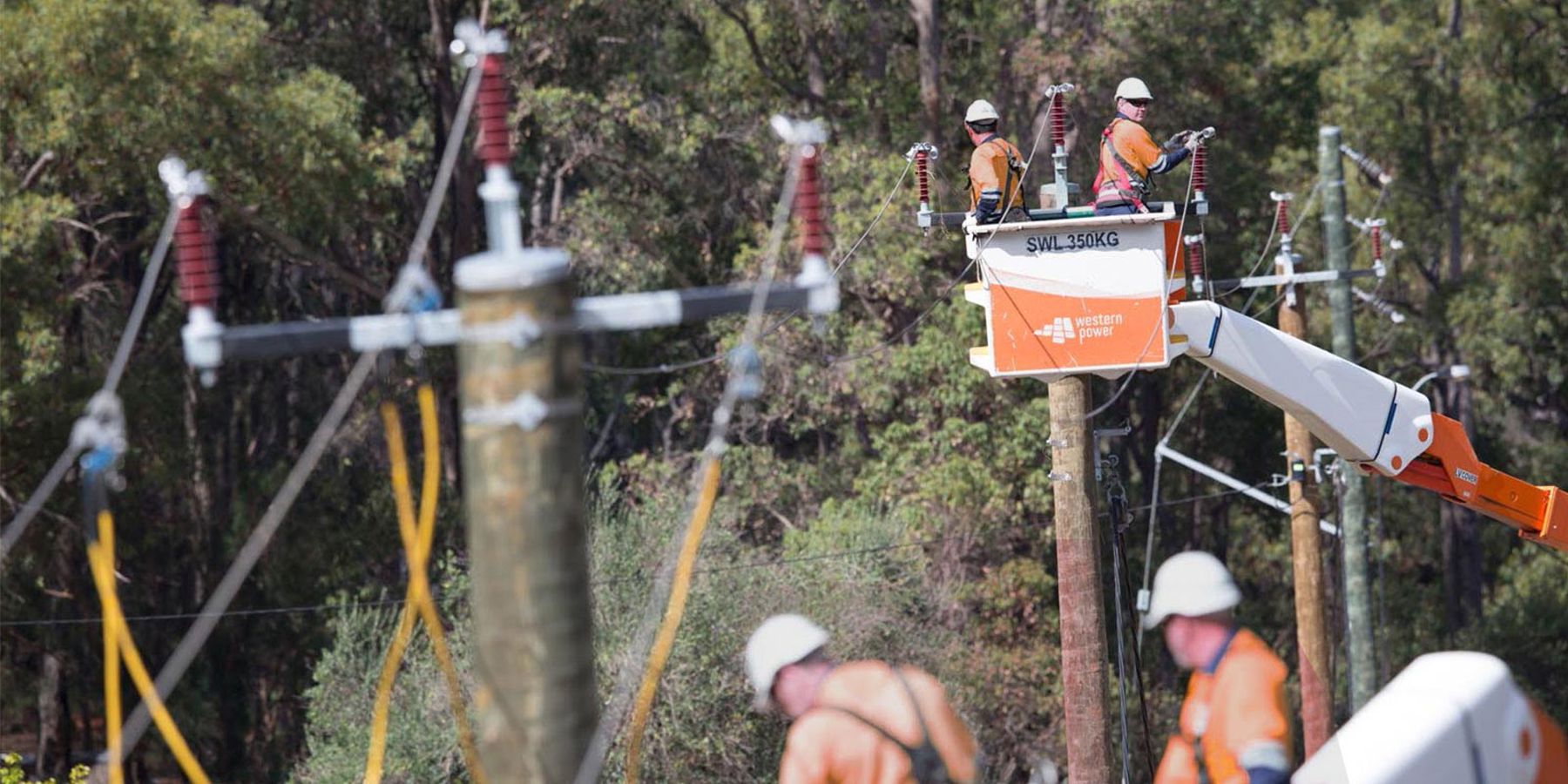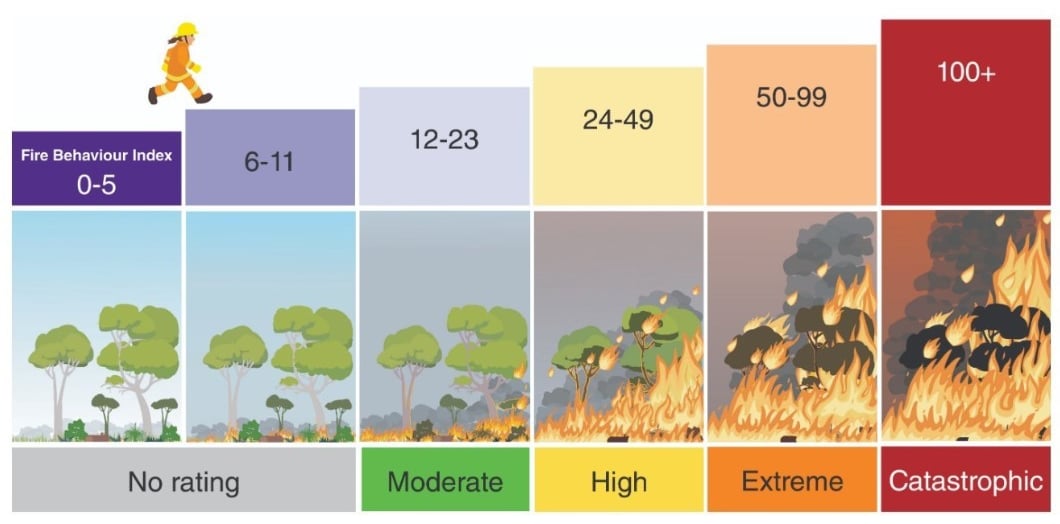
Managing Bushfire Risk
The ongoing impacts of climate change and forecasted increased risk of bushfires means we operate the network differently and are continually refining the way we mitigate bushfire risk across the network.
The combination of extreme heat, dry conditions and vast expanses mean that as a community we must work together to reduce the risk of bushfires and the potential damage they can cause. We all have a part to play.
That’s why every year we implement our bushfire mitigation strategy to reduce the risk of bushfire. This strategy includes a mix of smart network settings, proactive management of poles and wires in high/extreme bushfire zones and changing how we operate in response to fire weather conditions.
Every year before bushfire season, our crews are hard at work preparing the network in high and extreme bushfire risk zones to reduce the likelihood of a network-related spark that could cause a fire.
This includes:
- cutting back vegetation from poles and wires
- clearing vegetation at the base of poles
- inspection of assets in high and extreme fire risk areas
- pole replacement and conductor replacement as needed
- siliconing and washing of insulators.
2023/24 Summer
Extensive work was undertaken across the Western Power network to minimise bushfire risk, increase network resilience and improve reliability for the community.
We invested $152M in infrastructure maintenance and upgrades, and vegetation management in addition to annual maintenance.
As part of our commitment to delivering safe and reliable power supply to the community, we spent an additional $77M on pole replacements, $51M on conductor replacements and $24M on vegetation management to enhance safety and network resilience.
We inspected more than 150,000 poles in high and extreme fire risk areas and replaced more than 6,500 insulators.
We recommenced live line insulator washing and siliconing, added more emergency response generators and high voltage injection units to our fleet and continued upgrading distribution transformers and feeders across Perth’s suburbs and regional areas.
How does the network operate differently during bushfire season?
Most faults on the electricity network don’t cause significant network damage, for example when a falling branch strikes a powerline and causes a momentary short circuit. Our network smarts work to automatically detect and isolate these faults to avoid larger-scale outages. Even though attempting to re-energise the network may create a spark, in normal conditions the risk of starting a fire, is very low.
During bushfire season, we modify these settings that monitor the network to make them more sensitive.
When there is a fault or other interference during this period, the more sensitive settings ensure that power is interrupted faster than usual, and the power will remain off instead of being automatically restored until a patrol is completed or it is deemed safe to do so following a bushfire risk assessment.
This reduces the likelihood of starting a fire but results in more frequent outages that may last longer – particularly if we need to patrol the impacted lines.
These changes have the greatest impact on customers in regional communities where electricity is supplied by powerlines that travel through high and extreme bushfire risk areas, often over long distances.
Our response during bushfire weather conditions
Australian Fire Danger Rating System
As part of a national approach, Western Power aligns with the Australian Fire Danger Ratings System to ensure its assets in extreme and high bushfire risk areas are managed safely. More information can be found on the Australasian Fire Authorities Council website or on the DFES website.
As part of our bushfire risk assessment, during an unplanned outage, Western Power uses real time BOM forecasts for specific locations and considers the fire danger rating and fire behaviour index. Fire Behaviour Index (FBI) ratings take into consideration terrain and fuel load, temperature, and wind. We will not reenergise if it not safe to do so due to an Extreme of Catastrophic fire danger rating as this could lead to sparks causing a bushfire.
The FBI is a scale that is used consistently across Australia and require finer detail than the four Fire Danger Rating categories. The FBI runs from 0 to 100 and beyond, with increasingly high values indicating increasingly dangerous fire behaviour and therefore fire danger risk.
The FBI is split into step-up categories. Each step represents a transition in fire behaviour, such as a significant change in potential fire spread, suppression difficulty or the expected scale of impact to life and property (see figure below).  The safety of our crews and the community is critical, and we work closely with the Department of Fire and Emergency Services to make sure we have workable and effective exemptions in place to safely restore power on days where Total Fire Bans are in place as well as high fire danger ratings and FBIs.
The safety of our crews and the community is critical, and we work closely with the Department of Fire and Emergency Services to make sure we have workable and effective exemptions in place to safely restore power on days where Total Fire Bans are in place as well as high fire danger ratings and FBIs.
There are also fire and movement warnings that we consider when assessing risk and impact our activities:
Harvest and Vehicle Movement Ban (HVMB)
These bans are issued by the local government (LG) and mean that vehicle movement can only take place under specific conditions. This can result in customers experiencing longer outages due to our repair and restoration practices being limited. In these instances, power may not be restored until that evening or the next day, depending on when it is deemed to be safe enough to do so. We work closely with the LG to ensure we have workable exemption when it is safe to do so to restore power supply.
Fire Weather Warning
These warnings are when the Fire Danger Rating is forecast to be high, extreme or catastrophic. On these days, we won’t turn power back on after an outage without conducting a detailed bushfire risk assessment to any risks to ensure our activities won't generate a spark. This includes not allowing the network to automatically attempt to turn the power back on until we have sent a crew to patrol the powerline, either by vehicle or helicopter, and find the cause of the fault. The impact may be that we are unable to re-energise a line, or conduct other activities, until the fire risk has reduced. Some regional powerlines are hundreds of kilometres long, so this can take some time.
In the event of an outage during these conditions, you may be without power for an extended period of time, possibly until late in the evening when the fire danger rating lowers.
Using the real time, localised forecasting and data, we have made significant improvements to ensure that, where possible and safe to do so, we are able to restore power more quickly.
Our FAQs provide some information on how you can prepare for an extended outage.
Outage communications
We’ve reviewed and improved our customer and stakeholder communications in the lead up to, and during, outage events to keep customers better updated with timely and effective information. We now have an automatic opt-in for over one million of our residential customers, enabling them to receive SMS notifications when an unplanned outage affects their property. Business accounts can also register for this service. We’ve also enabled customers to self-manage SMS outage subscriptions directly from their phone.
In addition to SMS enhancements, we’re undertaking digital improvement projects aimed at transforming customer experiences, including improved website and portal features. Key features of our new website include the ability to view a timeline of any power outage and response, save favourite outage locations and view planned outages 10 days in advance and save the information to calendars.
We’ve also partnered with the Department of Fire and Emergency Services (DFES) to provide power outage information on Emergency WA during an emergency incident that impacts significant sections of the South West Interconnected System.
What is our process to repair and restore power?
Our first priority is the safety of our crews, you and your community.
Here are some of the steps we take to repair and restore power after an incident
Safety first
1
Repair work starts
2
Start restoring power
3
Bulk customers restored
4
Are you bushfire ready?
Need to prepare your own property for bushfire season? The Department of Fire and Emergency Services (DFES) has developed resources for property owners to be bushfire ready.
For advice on how to prepare your property, daily updates of areas affected by fire restrictions and details on emergency situations, visit the Emergency WA website.
How you can help prepare for bushfire season
- Keep vegetation pruned back. Cut long grass and prune back trees so they are a safe distance from powerlines. Learn the clearance zones for a safe minimum distance.
- Clear your roof gutters and remove rubbish from around your property.
- Be prepared for an outage - have an emergency water supply, learn how to operate automatic garage doors or gates without power, keep a torch and spare batteries handy. For more information on how to prepare, visit the DFES website.
- If you see a fallen / damaged powerline or an emergency situation affecting the electricity network, stay clear and make the safe call on 13 13 51 (24/7).
- If you see a spark or fire in vegetation, no matter how small, call 000 immediately.
- If you experience an outage in bushfire season, please be patient. We understand it can be inconvenient and frustrating, but we will restore power as soon as it is safe to do so.
What if you experience an extended outage
If you experience an outage lasting 12 continuous hours or more, you may be eligible for an $120 payment under the State Government's extended outage payment scheme.